
Blumenstein Castle is an estate house in the municipality of Solothurn of the Canton of Solothurn in Switzerland. It is a Swiss heritage site of national significance. [1] In 1952 it became the home of the Historical Museum of Solothurn.

Blumenstein Castle is an estate house in the municipality of Solothurn of the Canton of Solothurn in Switzerland. It is a Swiss heritage site of national significance. [1] In 1952 it became the home of the Historical Museum of Solothurn.

The Régence style house was built in 1725–28 for the governor Franz Heinrich von Stäffis-Mollondin in the center of a 20 hectares (49 acres) terraced park. [2] After Franz Heinrich's death in 1749 the estate passed to his son Joseph Lorenz von Stäffis-Mollondin. When Joseph died in 1758 without an heir the Stäffis-Mollondin family ended and the estate was divided between his daughters Johanna Karolina Anophe and Ludovika Franziska, their grandmother Jeanne Charlotte Cléophe and their mother Marie Jeanne Nicole. In 1797 Ludovika Franziska married Robert Fidel Carl Wallier von St. Aubin and the entire estate passed to the von St. Aubin family. In 1847 Ludovika Franziska died and Blumenstein passed to her sister in law Charlotte Glutz-Wallier von St. Aubin. About a decade later, in 1856, her sons Edmund, Ludwig and Alfred Glutz-Ruchti inherited the house. [3] In 1861 Edmund bought out his brothers shares and became the only owner of Blumestein.
Edmund Glutz-Ruchti bequeathed Blumenstein in 1885 to his nephew Joseph Glutz-Ruchti. Over next decades Joseph modernized the old building and installed central heating which changed it from a summer residence into a home that was comfortable year round. He supported the renovations and lavish lifestyle by selling the furnishings and the lands around the estate. However, by the mid-1920s he was insolvent. When Joseph went bankrupt, Blumenstein was sold at auction. [3] [4] On 18 October 1928, the Basel architect HR Steuer bought the empty castle and the remaining garden for 400,000 Francs. The garden was divided into lots and sold as building land. [4]
The main building and the land immediately around the building were purchased on 11 September 1933 by Fritz Hirt-Baumgartner for 85,000 francs. [4] Over the following two decades Fritz Hirt-Baumgartner and his wife Lucie attempted to buy back all the furnishings and outbuildings from Blumenstein. [3]
On 7 February 1951 the couple sold Blumenstein for CHF 180,000 along with its inventory for CHF 40,000 to the municipality of Solothurn. [4] The Blumenstein Museum or Historical Museum of Solothurn opened on 3 May 1952. Fritz Hirt-Baumgartner's wife Lucie retained the right to reside in several rooms of the upper floor until her death in 1977. [3]
Today the museum is open Tuesday to Saturday from 2:00PM to 5:00PM and Sunday from 10:00AM until 5:00PM. It is closed Mondays and some holidays. Admission is free and some rooms are available to rent for parties and meetings. [5]
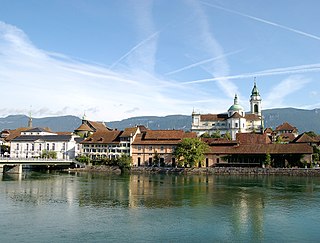
Solothurn is a town, a municipality, and the capital of the canton of Solothurn in Switzerland. It is located in the north-west of Switzerland on the banks of the Aare and on the foot of the Weissenstein Jura mountains.
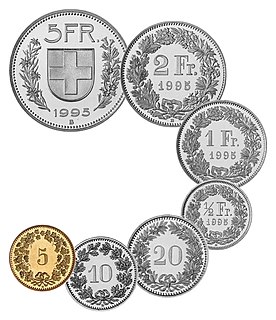
The franc is the currency and legal tender of Switzerland and Liechtenstein; it is also legal tender in the Italian exclave of Campione d'Italia. The Swiss National Bank (SNB) issues banknotes and the federal mint Swissmint issues coins.
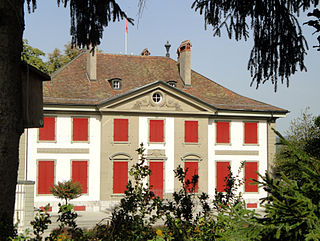
The rural palace of Lohn in Kehrsatz, near Bern, Switzerland, is the official estate of the Swiss Federal Council, the government of Switzerland. From 1942 to 1994, the Lohn Estate accommodated the official guests of the Swiss Confederation. It is a Swiss heritage site of national significance.

Rüeggisberg Priory was a Cluniac priory in the municipality of Rüeggisberg, Canton of Bern, Switzerland.
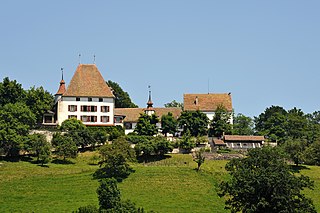
Burgistein is a municipality in the administrative district of Thun in the canton of Bern in Switzerland.
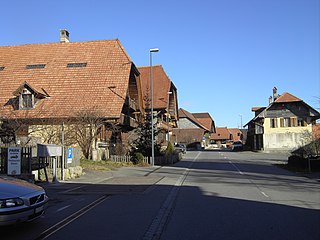
Rüeggisberg is a municipality in the Bern-Mittelland administrative district in the canton of Bern in Switzerland.
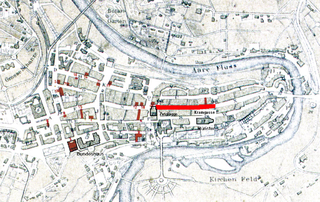
The Kramgasse is one of the principal streets in the Old City of Bern, the medieval city centre of Bern, Switzerland. It was the center of urban life in Bern until the 19th century. Today, it is a popular shopping street. Its length, slight curve and long line of Baroque façades combine to produce Bern's most impressive streetscape.

The Junkerngasse is a street in the Old City of Bern, the medieval city center of Bern, Switzerland. It connects the tip of the Aar peninsula to the Münster.

The coins of the Swiss franc are the official coins used in Switzerland and Liechtenstein. The name of the subunit is centime in French and internationally, Rappen in German, centesimo in Italian, and rap in Romansh.

Silja Walter was a Swiss author and Benedictine nun in the Fahr Abbey in Switzerland. Born as Cécile Walter in Rickenbach, Solothurn, in Switzerland, at the age of 30 she became a nun: her religious name was Maria Hedwig (OSB). Her brother, Otto F. Walter, was also a popular Swiss author.

Jegenstorf Castle is a castle in the municipality of Jegenstorf of the Canton of Bern in Switzerland. It is a Swiss heritage site of national significance.

Köniz Castle is a castle in the municipality of Köniz of the Canton of Bern in Switzerland. It is a Swiss heritage site of national significance.
Robert James Shuttleworth was an English botanist and malacologist.

Gutenberg Castle is an intact castle in the town of Balzers, Liechtenstein, in the centre of the municipality of Balzers, the southern-most municipality in the country. Gutenberg is one of the five castles of the principality and one of two that have survived intact until the present day.
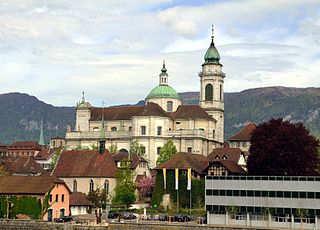
The St. Ursus Cathedral or Solothurn Cathedral is the cathedral of the Roman Catholic Diocese of Basel in the city of Solothurn, Switzerland. It is a Swiss heritage site of national significance.

Gottfried Keller-Stiftung, commonly abbreviated to GKS, is an arts foundation focused on cultural heritage of Switzerland. It was named by its founder Lydia Welti-Escher (1858–1891) after the Swiss national poet Gottfried Keller (1819–1891).

Kloster Allerheiligen is a former Benedictine monastery in the Swiss municipality of Schaffhausen in the Canton of Schaffhausen. The church Münster Allerheiligen is the oldest building in Schaffhausen, and houses also the Museum zu Allerheiligen.

Münster is one of the two main churches of the old town of the Swiss city of Schaffhausen. First built in 1064 AD as a Romanesque Basilica of the then Benecdictine Kloster Allerheiligen, it was rebuilt several times, and became in 1524 the Reformed Church of the city of Schaffhausen.

Augustinerkloster was one of the eight monasteries within the medieval city of Zürich in Switzerland. It was founded around 1270 as an Augustinian Order priory on the site of the present Augustinerkirche Zürich on Münzplatz, and was abolished in 1524.
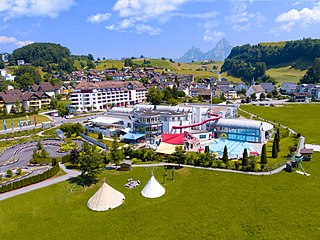
Swiss Holiday Park is a holiday and leisure resort in Morschach, Switzerland, one of the largest such resorts in the country. The park has around 600,000 visitors every year.